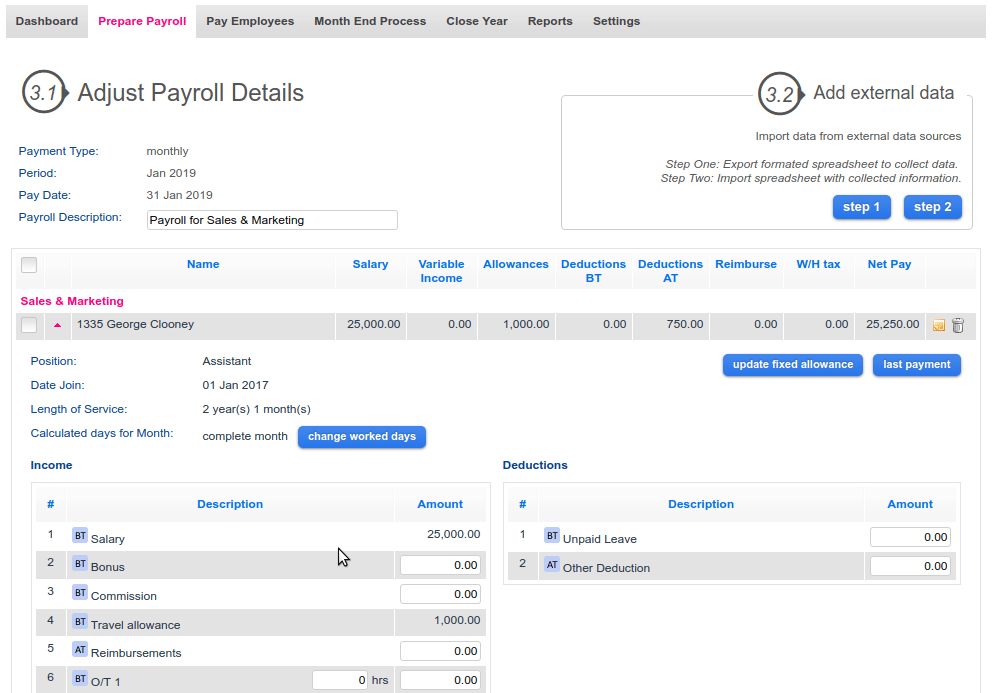Totem payroll always is compliant with Thai Labour Law.
A payroll package needs to handle a number of scenarios relating to where staff may have not completed their full pay period. Reasons for this may be:
- Leave without Pay (LWOP) ie: employee has taken leave for which they are not entitled to be paid.
- Incomplete period due to the employee commencing after the start of the calendar month; or an employee resignation or termination prior to the end of calendar month.
Let’s discover how these situations will be handled by Totem payroll.
Scenario 1 – LWOP
Leave without Pay. If Totem Leave Management (TLM) is being used, the payroll will automatically be adjusted at the time of preparation, if TLM is not used the Payroll preparer can manually adjust the period of LWOP when preparing the payroll. There is a button <change worked days> which is shown when an employee’s pay details are expanded and the preparer only needs to make a change to the days to make the deduction. The calculation will be automatic (see below).
Whether LWOP is input by the Leave Management system, or manually, the calculation for LWOP is the same.
Note: Adjustments are not only made to the employee’s salary, but also to any fixed allowances and fixed deductions for which the employee is eligible.
It is possible to manage which items are calculated at Settings | Organisation | Legal Entities | [the Relevant Legal Entity] | Payroll (tab) | where there is a selector to choose Prorate Items for Unpaid Leave. Both allowances and deductions can be entered here.

Totem will calculate the amount to be deducted as follows:
- Firstly, the amount of days that the employee works is found from Settings | Legal Entity | Working Days per Period (the default being 30 days). 30 days will always be used as the base number of days in any month.
- Secondly, Totem uses the employee’s salary amount: Settings | Employees | Employee Details | Payroll | Salary & O/T | Current base salary and this amount is then divided by the number of days the employee works. This results in a fraction that is rounded upto the nearest stang.
Example 1: 2 days LWOP = 2/30 of the month
result equals 30 days in month -2 days LWOP, resulting Factor = 28/30.
Salary, fixed allowances and deductions will use the calculated factor as a multiplier to calculate changes to salary, fixed allowances and deductions. Rounding of the result is to the nearest stang.
The calculation also applies to fixed allowances or fixed deductions for which the employee is eligible. (See screen 1 above)
Scenario 2 – Where the employment commences after the start of the calendar month (late joiner), or ends before the end of the month (resignation)
Totem uses 30 days as the standard working month, irrespective of the number of days within that month.
Totem then counts the number of days the employee has been present during that period.
Example 2: employee first day is 4th of {Any Month}
Calculation is then number of days not worked =3 days, then result equals 30 days in month -3 days, resulting Factor = 27/30.
Example 3: employee last day is 21st {Any Month}
Totem calculates the number of days worked, 21 days resulting Factor = 21/30.
Fixed allowances and deductions will use the calculated factor as a multiplier to calculate changes to fixed allowances and deductions. Rounding of the result is to the nearest stang.
Note that even if an employee starts work or ends work during a month that does not have 30 days, ie January, February, March, May, July, August, October, and December then the calculation may not be as is logically expected, however, it is possible to over-ride this at the time of preparing payroll.
For more details, see Department of Labour Protection and Welfare published clarification RNG 0504/00683 dated 10 May 2013.
หัวข้อ : กฎหมายแรงงานไทย การแบ่งจ่ายเงินเดือนและ การลาที่ไม่ได้รับค่าจ้าง
จัดการกับบัญชีเงินเดือนอย่างไรเมื่อ พนักงาน ขาดงาน เข้างาน ลาออก หรือยุติการจ้างงาน
Totem Payroll ช่วยคุณได้
การทำงานTotem Payroll ยึดถือแนวปฏิบัติตามข้อกฎหมายแรงงานไทยอย่างเคร่งครัด
โปรแกรมบัญชีเงินเดือนจำเป็นต้องจัดการกับสถานการณ์หลายอย่างที่เกี่ยวข้องกับพนักงานซึ่งได้รับค่าจ้างไม่เต็มช่วงเวลา อันอาจเกิดจากสาเหตุ ดังนี้
1. การลาหยุดที่ไม่ได้รับค้าจ้าง กล่าวคือ พนักงานลาหยุดงานโดยไม่มีสิทธิ์ได้รับค่าจ้าง
2.ระยะเวลาไม่ครบเดือน เนื่องจากพนักงานเริ่มงานหลังวันเริ่มต้นเดือนตามปฎิทิน หรือลาออก หรือยุติการทำงานก่อนวันสิ้นเดือน
มาดูกันว่าTotem Payroll จะจัดการกับบัญชีเงินเดือนจากสถานการณ์เหล่านี้อย่างไร
สถานการณ์ที่ 1 : การลาหยุดที่ไม่ได้รับค่าจ้าง
หลักการทำงานของ Totem Leave Management (TLM) นั้น บัญชีเงินเดือนจะถูกปรับอัตโนมัติระหว่างการเตรียมข้อมูล หรือถ้าหากไม่ได้ใช้ระบบจัดการอัตโนมัติของ Totem ผู้ใช้จะต้องปรับเปลี่ยนข้อมูลระยะเวลาในการลาหยุดที่ไม่ได้รับค่าจ้างด้วยตนเอง โดยใช้คำสั่ง <เปลี่ยนวันทำงาน> ซึ่งคำสั่งนี้จะปรากฎขึ้นเมื่อเพิ่มรายละเอียดข้อมูลการจ่ายเงินของพนักงานเรียบร้อย และผู้จัดเตรียมบัญชีเท่านั้นที่ได้รับสิทธิ์ในการปรับเปลี่ยน/แก้ไขวันให้ลดลงได้ ซึ่งระบบจะคำนวนโดยอัตโนมัติ (ดูภาพด้านล่างล่าง)

ไม่ว่าการลาโดยไม่ได้รับค่าจ้างจะนำเข้าข้อมูลอัตโนมัติด้วยระบบการจัดการวันลา (Totem Leave) หรือจัดการด้วยตนเอง ระบบคำนวนการลาหยุดโดยไม่ได้รับค่าจ้างนั้นจะได้ผลลัพธ์เหมือนกัน
หมายเหตุ : การปรับเปลี่ยนดังกล่าว ไม่จำกัดเฉพาะเงินเดือนของพนักงานเท่านั้น แต่ยังรวมถึงรายได้ประจำอื่นๆ และรายหักอื่นๆ ที่มีจำนวนเท่ากันทุกๆ เดือนอีกด้วย
อนึ่ง สามารถใช้วิธีเดียวกันนี้ในการคำนวนรายการอื่น ทั้งในส่วนของรายรับและรายการหักต่างๆ โดยใช้เมนู ตั้งค่า | องค์กร | หน่วยงาน (เลือกหน่อยงานที่ต้องการ) | บัญชีเงินเดือน (แทบ) ไปที่รายการคำนวนการลาโดยไม่รับค่าจ้าง ซึ่งสามารถป้อนได้ที่นี้

- Totem จะคำนวนยอดการหักลบดังนี้ลำดับแรก ให้ตรวจเช็คจำนวนวันที่พนักงานทำงาน โดยตรวจเช็คได้จาก เมนู ตั้งค่า | หน่วยงาน | การทำงานต่องวด (ค่าเริ่มต้นคือ 30 วัน) ซึ่ง Totemใช้ค่า 30 วันเป็นฐานของวันในเดือนอื่นๆ ด้วย
- ลำดับถัดไป คือTotem จะคำนวนจากเงินเดือนของพนักงาน ไปที่ เมนู ตั้งค่า | พนักงาน | รายละเอียดพนักงาน (เลือกพนักงานที่ต้องการ) | บัญชีเงินเดือน | เงินเดือนและเงินล่วงเวลา | ฐานเงินเดือนปัจจุบัน และจำนวนเงินนี้จะถูกหารด้วยจำนวนวันที่พนักงานทำงาน ซึ่งถ้าผลลัพธ์ออกมาเป็นเศษจะถูกปัดเศษขึ้นไปยังเศษสตางค์ที่ใกล้ที่สุด
Totem จะคำนวนยอดการหักลบดังนี้ลำดับแรก ให้ตรวจเช็คจำนวนวันที่พนักงานทำงาน โดยตรวจเช็คได้จาก เมนู ตั้งค่า | หน่วยงาน | การทำงานต่องวด (ค่าเริ่มต้นคือ 30 วัน) ซึ่ง Totemใช้ค่า 30 วันเป็นฐานของวันในเดือนอื่นๆ ด้วย
ลำดับถัดไป คือTotem จะคำนวนจากเงินเดือนของพนักงาน ไปที่ เมนู ตั้งค่า | พนักงาน | รายละเอียดพนักงาน (เลือกพนักงานที่ต้องการ) | บัญชีเงินเดือน | เงินเดือนและเงินล่วงเวลา | ฐานเงินเดือนปัจจุบัน และจำนวนเงินนี้จะถูกหารด้วยจำนวนวันที่พนักงานทำงาน ซึ่งถ้าผลลัพธ์ออกมาเป็นเศษจะถูกปัดเศษขึ้นไปยังเศษสตางค์ที่ใกล้ที่สุด
ตัวอย่าง 1 : หนึ่งเดือนมี 30วัน ถ้าลาหยุดที่ไม่ได้รับค่าจ้าง 2 วัน ผลลัพธ์ คือทำงาน 28 วัน จาก 30 วัน
อนึ่ง Totem ใช้การคำนวนในลักษณะนี้ตามตัวอย่างด้านบน โดยจะนำมาใช้ในการคำนวณ เงินเดือน, รายได้และการหักอื่นๆที่คงที่ โดยจะปัดเศษสตางค์ไปยังสตางคืที่ใกล้ที่สุด (ตัวอย่างตามภาพด้านบน)
สถานการณ์ที่ 2 – เมื่อการจ้างงานเริ่มต้นหลังวันต้นเดือนในปฏิทิน (จ้างงาน) หรือการสิ้นสุดการจ้างงานก่อนวันสิ้นเดือน (การลาออก)
Totem ใช้จำนวน 30 วันเป็นมาตรฐานในการคำนวนวันทำงานต่อเดือนโดยไม่คำนึงถึงจำนวนวันในเดือนนั้น
ตัวอย่างที่ 2 : พนักงานเริ่มงานในวันที่ 4 (ของเดือนใดก็ได้) การคำนวณคือ นำจำนวนวัน ที่ลา 3วัน โดยหักออกจากจำนวนวันของเดือน (Totem ใช้ 30 วันเท่ากันทุกเดือน ไม่ว่าเดือนนั้นจะมี 28 หรือ 31 วัน) ได้ผลลัพธ์วันทำงานเท่ากับ 27 วัน ค่าที่ใช้ในการคำนวนคือ = 27/30
ตัวอย่างที่ 3 : วันสุดท้ายของพนักงานคือวันที่ 21 (เดือนใดก็ได้) Totem จะคำนวณจำนวนวันที่ทำงาน 21 วัน ค่าที่ใช้ในการคำนวนคือ = 21/30
รายได้ประจำอื่นๆ รวมถึงรายการหักอื่นๆ ที่มีเท่ากันทุกเดือน จะใช้หลักการคำนวนเช่นเดียวกับการคำนวนเงินเดือนในข้อที่ 1 โดยการปัดเศษจะปัดไปยังเศษสตางค์ที่ใกล้ที่สุด
ในกรณีที่พนักงานเริ่มทำงานหรือสิ้นสุดการทำงานในระหว่างเดือนที่ไม่ใช่ 30 วัน เช่น มกราคม กุมภาพันธ์ มีนาคม พฤษภาคม กรกฎาคม สิงหาคม ตุลาคม หรือธันวาคม ซึ่งการคำนวณข้างต้นอาจไม่เป็นไปตามนโยบายของบริษัท อย่างไรก็ตาม ผู้ใช้สามารถตั้งค่าใหม่ได้ในขั้นตอนการเตรียมบัญชีเงินดือน
ดูรายละเอียดเพิ่มเติมได้ที่กรมสวัสดิการและคุ้มครองแรงงานเผยแพร่คำชี้แจง RNG 0504/00683 ลงวันที่ 10 พฤษภาคม 2556


